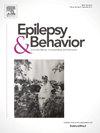成人多灶性癫痫的临床特点及预后。
IF 2.3
3区 医学
Q2 BEHAVIORAL SCIENCES
引用次数: 0
摘要
目的:多灶性癫痫是一种重要的癫痫亚型,但在一般临床实践中有时难以识别。在考虑手术切除时,区分(单)灶性和多灶性耐药癫痫是很重要的。存在多个独立的自主癫痫区可能限制手术选择神经调节或姑息性切除。我们描述了一组通过视频脑电图监测诊断为多灶性癫痫的患者的临床特征和结果。方法:从一个癫痫监测单位的数据库中确定9年期间可能的和可能的多灶性癫痫患者。描述了临床特征和长期结果。结果:我们根据临床评估和视频脑电图结果确定了30例患者,其中19例为可能的多灶性癫痫,11例为可能的多灶性癫痫。癫痫的病因主要是结构性的或不明原因的。在视频脑电图监测之前,临床评估包括确定癫痫发作符合学或常规脑电图提示只有13.3%的患者患有多灶性癫痫。超过95%的患者在最后随访时有持续的耐药癫痫发作。在9年的研究期间,有1例患者因癫痫猝死。意义:本研究强调,多局灶性癫痫往往不能识别或诊断在门诊设置。它通常是在视频脑电图监测后做出的诊断。根据我们的经验,多灶性癫痫通常是耐药的,而且往往是高度难治性的。认识到多局灶性癫痫患者是局灶性癫痫中一个更难以治疗的亚组,对咨询和管理方面的考虑很重要。本文章由计算机程序翻译,如有差异,请以英文原文为准。
Clinical characteristics and outcomes of adults with multifocal epilepsy
Objective
Multifocal epilepsy is an important subtype of epilepsy, but it is sometimes difficult to recognise in general clinical practice. Distinguishing (uni)focal from multifocal drug resistant epilepsy is important when considering surgical resection. The presence of multiple discrete autonomous epileptogenic zones may limit surgical options to neuromodulation or palliative resection. We describe the clinical characteristics and outcomes of a cohort of patients with multifocal epilepsy diagnosed by video-EEG monitoring.
Methods
Patients with probable and possible multifocal epilepsy were identified from an Epilepsy Monitoring Unit database during a 9-year period. Clinical characteristics and long term outcomes are described.
Results
We identified 30 patients- 19 with possible and 11 with probable multifocal epilepsy based on clinical assessment and video-EEG findings. The aetiology of epilepsy was structural or of unknown cause in the majority. Prior to video-EEG monitoring, clinical assessment including ascertainment of seizure semiology or routine EEG suggested multifocal epilepsy in only 13.3% of patients. Over 95% had ongoing drug resistant seizures at last follow up. One patient died from sudden unexpected death in epilepsy over the 9-year study interval.
Significance
This study highlights that multifocal epilepsy is often not recognised or diagnosed in the outpatient setting. Typically it is a diagnosis made after video-EEG monitoring. In our experience multifocal epilepsy is usually drug-resistant and often highly refractory. Recognising patients with multifocal epilepsy as a more treatment-resistant subgroup within focal epilepsy is important for counselling and management considerations.
求助全文
通过发布文献求助,成功后即可免费获取论文全文。
去求助
来源期刊

Epilepsy & Behavior
医学-行为科学
CiteScore
5.40
自引率
15.40%
发文量
385
审稿时长
43 days
期刊介绍:
Epilepsy & Behavior is the fastest-growing international journal uniquely devoted to the rapid dissemination of the most current information available on the behavioral aspects of seizures and epilepsy.
Epilepsy & Behavior presents original peer-reviewed articles based on laboratory and clinical research. Topics are drawn from a variety of fields, including clinical neurology, neurosurgery, neuropsychiatry, neuropsychology, neurophysiology, neuropharmacology, and neuroimaging.
From September 2012 Epilepsy & Behavior stopped accepting Case Reports for publication in the journal. From this date authors who submit to Epilepsy & Behavior will be offered a transfer or asked to resubmit their Case Reports to its new sister journal, Epilepsy & Behavior Case Reports.
 求助内容:
求助内容: 应助结果提醒方式:
应助结果提醒方式:


